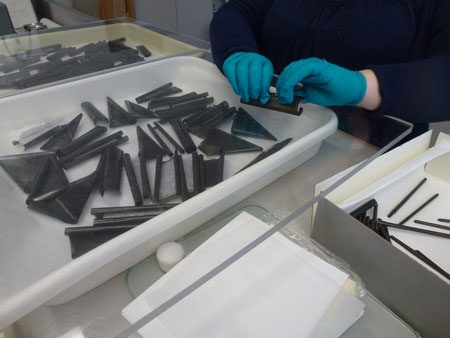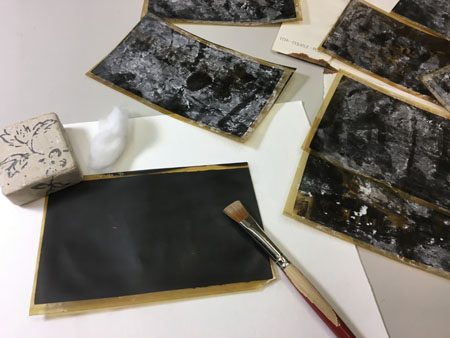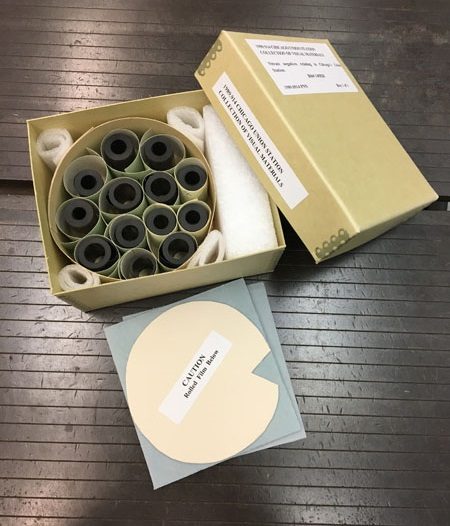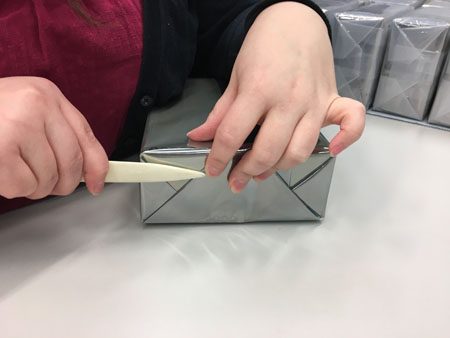As part of Monday Night Nitrates, our weekly photograph series, the Chicago History Museum collections staff is blogging about the process of digitizing approximately 35,000 nitrate negatives, a project funded by the Institute of Museum and Library Services. In this post, CHM paper conservator Carol Turchan writes about how the negatives were prepared for digitization and freezer storage.
The 2013 conservation condition survey was an important preliminary step toward digitizing and preserving our nitrate film collection, but did not prepare staff for issues discovered once the project began. As the conservator, my task was to prepare the boxes of film for permanent freezer storage. It would not be necessary to replace the negatives’ enclosures—envelopes and boxes—because degraded storage materials would not affect the film in its frozen state.
The collection was previously in cold storage in a rooftop vault, but had been out for a number of years because of work on the roof. The years in temporary storage added to the influence of degraded, crowded packaging, and may have led to further degradation of the unstable material.
Several individual collections required some level of conservation intervention. Negatives of the World’s Columbian Exposition were brittle and tightly curled because they lacked an anticurl layer. Humidification was required to relax the film for scanning. Two conservators assisted the photographer in moving negatives one at a time from tray to copy stand before the film dried and reverted to its curled state.

We gradually relaxed tightly curled negatives from one collection by humidifying them for three hours. Each negative was then quickly slipped under glass to be scanned before it curled again. All images by CHM staff
Strips of 35mm film from another collection became brittle and twisted while constrained within channels of plastic sleeves. Forty-one negatives from yet another collection were curled together and had to be peeled apart one at a time. Other unexpected anomalies were powdery residues on surfaces, lifting of gelatin, image-bearing layers from unusually thick nitrate bases, and batches of thin, very brittle negatives stuck together. Despite the many interesting condition issues we confronted, it was reassuring that an image could be salvaged digitally in almost all cases.

There were some conservation issues among the collections. Here, powdery residues are brushed from surfaces of a negative.
After digitization and capture of metadata for each image, conservation began packaging 285 various-sized boxes of film for permanent preservation in seven freezers purchased under the IMLS grant. Each box of film requires two layers of protective plastic wrapping before moving to freezer storage.

Before wrapping boxes of film for freezing, voids must be filled with archival material to reduce air spaces.

Static-Shield™ film and 6ml polyethylene are two layers of plastic film required for freezer storage. All seams were carefully sealed with self-adhesive tape.
To avoid trapping moisture in boxes, wrapping began in winter 2017 when relative humidity (RH) was lower in the Paper Lab. Empty spaces in boxes were filled with archival, absorbent materials to eliminate trapped air. Boxes were labelled, a humidity indicator placed on the box next to the label, and the first wrapping of thin, Static Shield film applied. All seams were sealed with self-adhesive tape that will endure freezing temperatures. Another humidity indicator was placed near the first before the second wrapping of heavy, 6ml polyethylene was applied. The indicators will monitor RH in the box and between layers. After all seams were sealed with tape, the box was ready for the freezer.

Freezer #3 of 7 is filled. The temperature will be maintained at -20˚C (-4˚F). One freezer will remain empty to accommodate contents of a freezer when defrosting is required.
Shelf arrangement is determined before introducing wrapped boxes to freezers, and shelf numbers noted for future access. With freezers loaded and rarely opened, frost should be slow to form on shelves, but when necessary to defrost, contents will be moved to an empty freezer reserved for that purpose. The freezer number will move with its contents. Staff will periodically monitor for freezer temperature, excessive frost on shelves, and RH in packages. It’s estimated that freezing the film around –4˚ F will extend its life for 1,000 years.